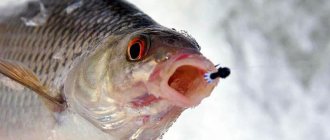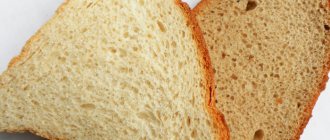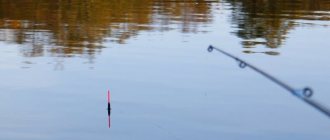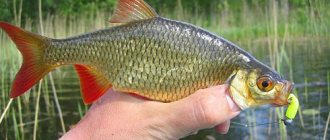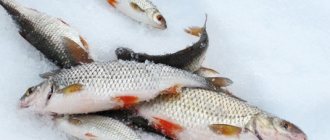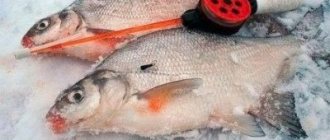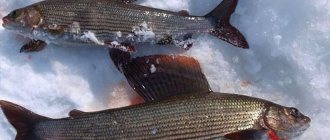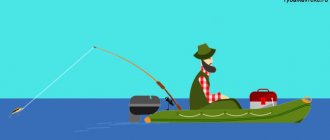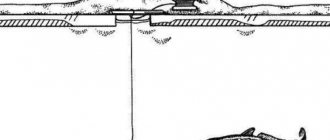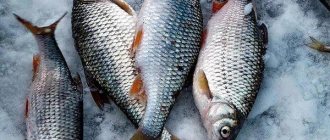Many anglers will agree that fishing tackle for roach in the summer is the most effective float tackle for this time of year. This method has proven itself well when fishing on the river, when the current draws the bait into the waters of tree branches hanging over the reservoir and along the border of coastal aquatic vegetation. Indeed, during the current, the roach behaves more boldly and decisively. Catching roach in line is a fairly active type of fishing. Catching fish this way will give you a lot of pleasant emotions and, of course, a good catch.
Assembling fishing tackle into wiring
For this method of fishing, a telescopic rod with blind rigging and a length of about five to six meters is used. It is equipped with a reel and guide rings. Approximately 30-40 meters of fishing line with a diameter of 0.18 - 0.2 mm are wound onto the reel. A sensitive float, special for fishing in currents, equipped with a long keel, sinkers, and a leash with a hook are attached to the fishing line. For the leash, take a fishing line 20-35 cm long and 0.15 mm in diameter, hooks are selected depending on the nozzle, the universal option is No. 10. If the catch of roach will take place in places where the depth of the reservoir exceeds the length of the rod, it is necessary to use a sliding float together with a stopper on the fishing line. Such a float allows you to throw tackle to remote places and even to the opposite bank of the river.
What is wiring?
The use of float gear (the so-called “Bolognese”) is a prerequisite for fishing from a boat or from the shore to please fans of such fishing with excellent results. The depth of the river should be sufficient for the bait on the hook to pass along the bottom, practically touching it.
The process is not complicated: after releasing the equipment into the water (while avoiding the fishing line getting caught on one of the rings), the reel is released and, placing the float on the current, it is sent into free swimming. The bait on the hook must be moved above the feeding areas.
There are three types of postings:
- the usual simplest technique (passive, with holding and catching with a wire);
- long-distance bait delivery technique;
- short-range wiring technique.
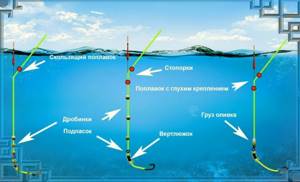
The simplest technique
In this way, the line is easily released from the reel, allowing it to move evenly with the current. This makes it easier for the nozzle to change its position and adapt to the movement of water. A technique that does not require much effort from the fisherman is called passive or free. It justifies itself in places where schools of bottom dwellers gather and when there is active biting.
However, anglers more often use the holding technique, slowing down the unwinding of the fishing line from the reel spool with their finger. In this case, the float stops, moving at a lower speed than the water, and the nozzle rises upward under the influence of the current. After some time, the line is released again, and the tackle moves on. Such movements of the food attract the attention of the fish and provoke them to swallow the bait.
In cases where the float, while being held, jumps out of the water column or rapidly approaches the coastal zone, the number of manipulations should be reduced.
The technique of fishing with a wire is that the weight and leash move along the bottom, and the bait moves in front under the influence of the current.
From time to time the angler must hold the tackle. The wiring will be effective if the depth is set correctly and the antenna on the float tilts with the current. The application of the technique proves its effectiveness in the case when a school of fish is in the middle layers.
To learn more:
Mikado fishing rods: beware of fakes!
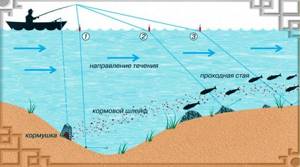
Far technique
The wisdom of this option is that the gear allows you to swim a distance of 20-30 meters. It should be noted that the initial casting distance should not exceed the length of the rod by more than twice. Long-distance fishing is preferred in water areas with strong currents and depths of no more than three meters, as well as in cases where a diligent fisherman has to fish hard-to-reach places, and casting is done in a strong tailwind.
In practice, this wiring is carried out according to the following scheme: the float is thrown to the required distance from the shore line, for some time it moves downstream to the original point of wiring. Then, by controlling the holding force of the floating float, it is forced to move along the desired trajectory.
In cases where the wind blows the float towards the fisherman, the tackle must be cast further away, and when he approaches the starting point of the retrieve, move it to the required distance with the help of a rod, controlling the strength and holding time.
Close wiring
This fishing technique is most common and is used in places with great depths and slow water movement. It depends on the influence of the wind (a vortex with the current interferes, but against it helps), and strong gusts do not allow the use of short-range guiding methods at all.
This type of bait delivery is carried out at distances ranging from 10 to 15 meters. It allows you to fish over long distances (maximum performance depends on the length of the rod used and the depths in the fishing areas). Such postings require close attention to ensure that the telescope or feeder stick is located towards the shore, and the angle between the float and the fishing line hanging from the tip of the rod relative to the angler’s location is close to 90°.
You need to get used to the process, since at first it will be difficult to keep the float on the desired trajectory. The success of fishing depends not only on the speed of the current, the number and frequency of holds, but also on the weight of the equipment. Weakly loaded tackle is harder to stop in time, but if you make it heavier, you will lose the sensitivity of bites.
Wire fishing technique
Catching roach in a fishing line on the river is carried out as follows: the float is carried out by swimming, the nozzle should be lowered 3-10 centimeters from the bottom. You need to hold the bait every few meters of swimming. The stop only lasts a couple of seconds, especially if the current is strong. Here you need to adhere to the principle: the faster the flow speed, the shorter the hold. A fast flow of water can lift the bait 60 cm from the bottom in one to two seconds. From such a height it will sink to the bottom, playing and attracting the attention of fish.
Dependence of wiring on the type of coils
Casting using inertia-free models does not allow the bait to move freely with the current and without jerking. The fish do not like this behavior of the food. To fix the problem, you need to work with the rod - point its blank in the direction of the current, and wait until the stick follows the float in a smooth arc, release about 2 meters of line from the reel, and return the rod to its original position. True, even this does not always help to avoid torn wiring.
To learn more:
Tackle and technique for catching catfish
The use of inertial-type reels (often called “flying”) allows for more effective bait presentations without the use of a fishing rod. By holding the drum with your finger, it is much easier to adjust the delivery speed of the nozzle. The line will move without jerking, and the bait will not jump.
Such reels have proven themselves to work over long distances, allowing you to slow down the equipment by lightly holding the drum. And in places with strong currents, the brake can be set in such a way that the reel line will unwind on its own. The fisherman will only have to pause it at the right moment in order to carry out the hold.
Groundbait and bait for roach in the wiring
Before you start fishing, you must feed the fish. Bait can be purchased at a fishing store, or you can simply use flour or white bread, adding bloodworms, maggots or finely chopped worms. You can use a fine mesh with a sinker as a feeder. The weight of the sinker should be sufficient to prevent the feeder from being carried away by the current. Having laid the bait mixture, we lower the feeder to the bottom, where the food will gradually wash out, attracting fish to the fishing spot.
As bait, you can use any food that roaches prefer to catch in the summer. These can be pieces of dough or bread crumb, as well as other attachments, preferably of plant origin: corn, peas or even algae. Despite the summer vegetarianism of roach, worms and maggots also give good bite results.
If you have assembled your gear correctly, chosen a fishing spot and stocked up on bait, fishing for roach in the wire will give you real pleasure. And we wish you good luck!
Bait and bait
In summer, large roaches on a small river are most attracted to plant baits and bread . Young canned “Bonduelle” corn, which is placed in the form of one or two grains on a hook, is very tempting for roaches. Sometimes replanting one or two red maggot larvae has a positive effect.
Another bait to which roach also actively reacts and often even better than to corn is black and white bread . You just need to use a different ersatz product, which is usually sold in our Pyaterochka stores and has no right to be called bread, but you need to take bread only from those bakeries that do not use chemical yeast with acid, but natural products. Their bread really smells like bread, like in the good old Soviet times, especially if the bread is still warm. Brown bread is used in the form of a crumb, and wheat bread is used in the form of a crust cut into cubes. Such a cube is pierced with a hook first from the hard part, then the tip of the hook is rotated in the pulp and brought back under the hard part of the crust.
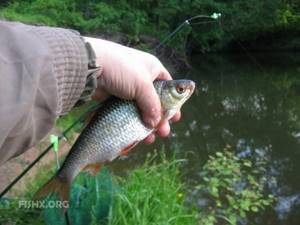
Share with your friends!
Feeding tactics
Having decided on the location, the first thing I do is add water to the bait, mix it thoroughly and leave it to swell and soak. In the meantime, I’m busy setting up a fishing area. To begin with, I will remove all stick branches and overhanging vegetation to avoid the equipment getting caught on them during casting. For the same purpose, I clear the space in front of me. I will definitely fix a couple of fishing rod stands in the ground parallel to the river - they are not directly involved in the wiring process, but they will be indispensable when tying the equipment, adjusting the depth and other issues. I place the rod on stands, and not in the grass covered with dew, so that the line does not stick to the blank. For the same purpose, I keep a piece of a clean, dry rag on hand so that from time to time I can wipe the rod blank from moisture, which is often present in the form of condensation in the early morning. Next, I unfold the chair (it is advisable to sit on the ground while fishing only if there is good insulation of the buttocks from the cold spring soil - a polyurethane foam mat will do this task perfectly), I place the landing net and fish tank within arm’s reach. I place containers with bait and leash holders with extra leash nearby so that during the fishing process I don’t have to run after them.
Next, I begin to lure fish, based on the fact that the length of the line usually does not exceed five meters with a casting length of 5-6 m from the shore, that is, the line comes almost from the point of the fishing rod.
Read! Catching crucian carp in an overgrown pond
It’s just great if downstream there is a blockage of cramps, bushes, trees - there will be fish there one hundred percent. I immediately try to outline for myself a clear trajectory for running the float - “from now to now.” I begin to throw the bait balls a little higher from the intended casting point so that the current does not drag them lower, and there is a bare, unbaited place left on the wiring section. Gradually, at short intervals, I throw the balls, forming a kind of path to a blockage of cramps or some other bottom anomaly. In this way, it is possible to lure the fish even from a remote shelter to the fishing site. If the current is strong, then I flatten the balls of bait into sort of cakes so that they cling better to the bottom soil and do not roll over it.
I usually make about half of the initial feeding more crumbly, which helps create an abundant trail of feed. And the density of the balls, which I supplement with during the fishing process, will depend on the bite.
While the bait begins to work, collecting fish, I am adjusting the equipment. To begin with, I lower the float so that its sensitivity is not lost and is clearly visible. I try to surround even a float with a long antenna so that only its tip protrudes from the water - if the wind rises at dawn, and even blowing with the current, then my alarm will be less affected by the wind than when the antenna is long, albeit thin.
Feeding a place for fishing from a boat
The best option for feeding the zone would be to use a metal cage with bait balls. We lower it to the bottom just above the current. We always throw the tackle next to the fish tank so as not to catch it with the hook. The food will be washed away by the current, creating a path along the edge. The bait will swim along this path. If the current in the fishing area is minimal, then periodically we take out the fish tank and move it a little so that the food is washed out faster. We make the balls of medium density so that on the one hand they do not disintegrate very quickly, but on the other they collect a little dust, creating an attractive cloud of turbidity.
The starter feed consists of 7-8 balls the size of an orange. Next, as they are washed out, we place 1-2 balls in the net every 30-40 minutes.
If the current in the fishing area is stronger, then the bait is weighted with clay or soil. The balls are rolled more densely to achieve uniform washout of the mixture. The amount of bait depends on the duration of fishing. If we fish for 5-6 hours, then 5 kg of the mixture will be enough. Moreover, the simplest one will do. You can mix 1 kg of crackers, 1 kg of flour and 1 kg of store-bought bait and add 2 kg of boiled millet. You can use 100 g as a flavoring. coriander or several packs of vanillin. It is better to moisten the mixture with water from the river.
The best baits would be maggot, worm, mastyrka, pearl barley and bread.
Preparing the fishing site
The next step is to accurately measure the depths in the wiring area. I always do this without removing the leash. In order to avoid snagging and subsequent fuss with the almost inevitable breakage of the leash when setting the wiring depth, I select the densest grain of wheat or pearl barley and place it on the hook, covering the tip and thereby reducing the likelihood of snags to zero. With this method, you can even drag the rig openly along the bottom, looking for places for wiring by dragging along the bottom. By the way, I noticed that the higher the sun, the deeper the fish go. Therefore, for a specific place, I outline for myself several paths for the float to float at different distances from the shore, and I try on each such path with several passages. Having determined the depth, I put the rod on the stand and, pulling the line, noting to myself the position of the float (for example, 5 cm above the third guide ring). This will help set the initial depth, which can be lost during sharp hooking and casting.
Read! Fishing for crucian carp in the swamp
